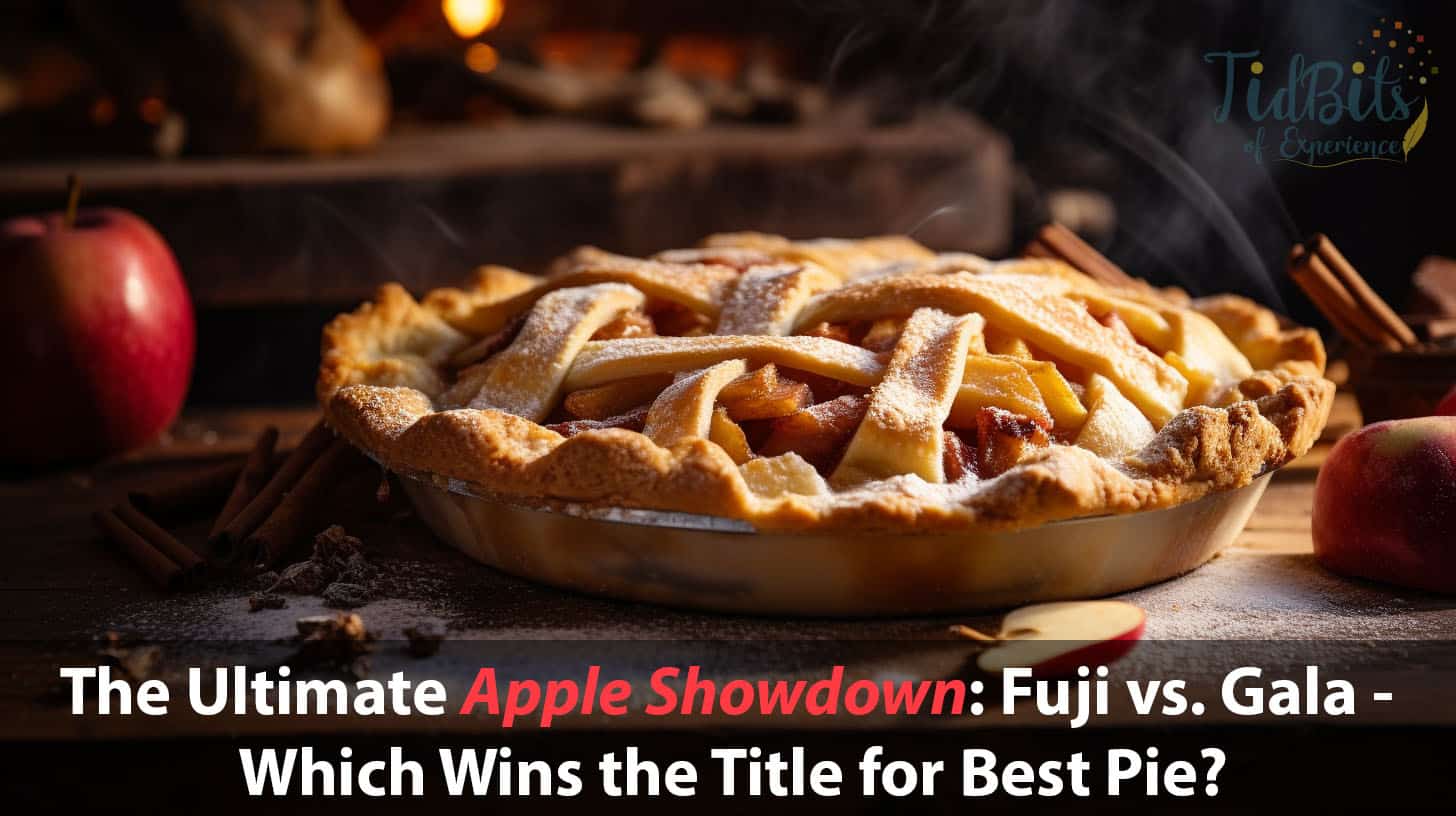You’re ready to bake the perfect apple pie, yet you can’t decide which apple is the best fit – Fuji or Gala? Trust me, I’ve been there too, and it can be quite a conundrum. Let’s delve into this flavorful battle between Fuji and Gala apples, dissecting their taste, texture, and overall suitability in your beloved pie.
Ready to uncover the secret ingredient for your next crowd-pleasing dessert?
Key Takeaways
The choice between Fuji and Gala apples for apple pie depends on personal preference, with Fuji offering a sweeter flavor profile and Gala providing a balance of tartness.
Both varieties have distinct textures that are ideal for baking, with Fuji maintaining its firmness when baked and Gala softening without becoming mushy.
The color of the apples also contributes to the overall appearance of the pie, with Fuji having a deeper red color and Gala bringing a bright orange-red hue.
It’s important to choose apples that are in season (September to November) for optimal freshness and flavor in your apple pie.
Table of Contents
Understanding the Essentials of Baking Apple Pie
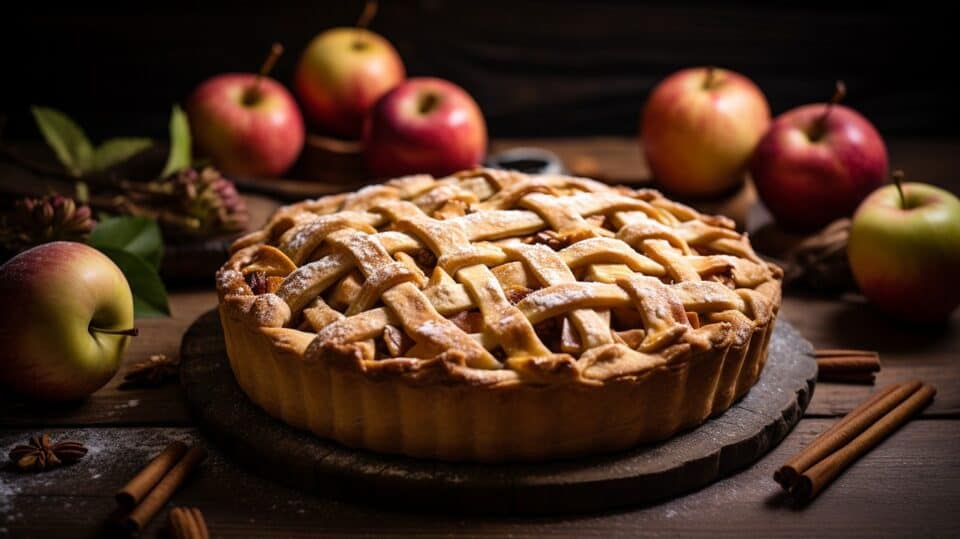
To create the perfect apple pie, it’s crucial to select the right type of apple and understand the importance of factors like browning and texture.
Selecting the right type of apple
Choosing the perfect apple for your pie can be a bit daunting with so many varieties available. From my extensive testing of different cultivars like Fuji, Gala, Granny Smith, and beyond, I’ve found that acid content plays a crucial role in the pie-making process.
Apples with higher acid levels not only help to prevent browning but also maintain an appealing firm texture even after baking. It’s important to note that each apple variety has its distinct flavor profile and sweetness level, which significantly impacts the taste of your masterpiece at the end.
And while some apples might taste great right from the tree, they may not withstand the heat in your oven, turning into a mushy filling instead of keeping their shape intact as desired for pies.
So next time you’re planning on whipping up a delicious homemade apple pie, remember the science behind choosing your apples!
The importance of apple’s browning and texture
Selecting the right type of apple for your pie is key to creating that perfect dessert experience. One crucial factor to consider is how the apple reacts when exposed to air, which we often refer to as browning.
Apples with high acid levels tend to brown less and retain a firmer texture when baked – resulting in a beautifully presented pie without mushy fillings. The Golden Delicious or Braeburn varieties are some good examples.
Another essential aspect is the texture of apples after baking them into a pie. Your aim should be finding those apples that soften nicely yet maintain their shape inside your piping-hot masterpiece.
If they disintegrate too much during cooking, you’ll end up with an unsatisfyingly mealy filling rather than distinct juicy pockets of apple goodness enclosed within flaky layers of pie crust.
To achieve this balance, J Kenji López-Alt recommends using a combination of different apple varieties in his book “The Food Lab: Better Home Cooking Through Science.”.
A Brief History of Fuji and Gala Apples
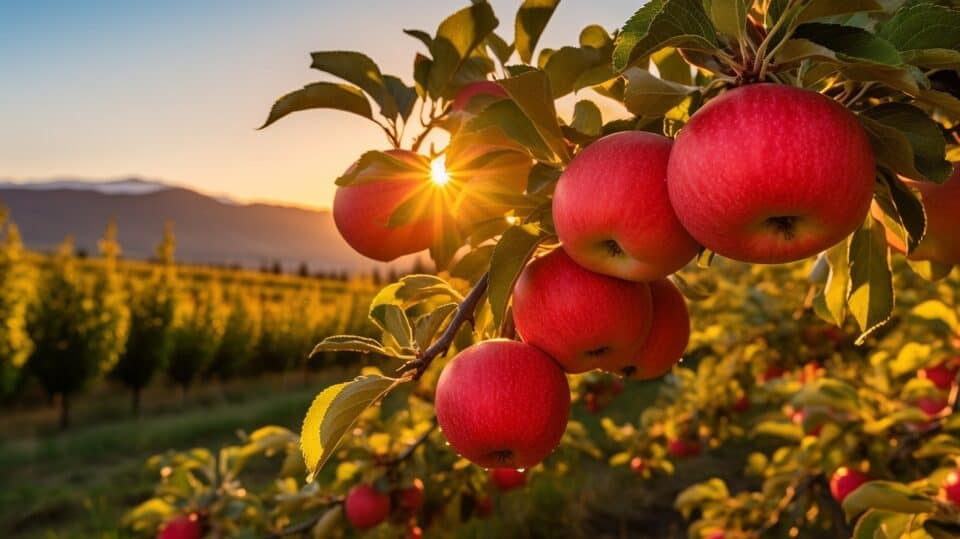
Believe it or not, Fuji apples and Gala apples come from opposite sides of the globe. In 1930, fruit farmers in Fujisaki, Japan, first developed the much-loved Fuji apple variety. This sweet-tart powerhouse comes with a citrusy flavor and did not make its way to the western part of the world until around the late 1960s.
On the other hand, Gala apples were born in New Zealand. An apple breeder by the name J.H.Kidd developed them back in 1934; its mellow and balanced sweet-tart charm didn’t hit our shores until roughly the middle-end of 1980.
The popularity of both these apple varieties for baking purposes has been on a steady rise ever since they made their entry into US markets, making them two top contenders for your next mouthwatering apple pie recipe!
Where Are Fuji and Gala Apples Grown?
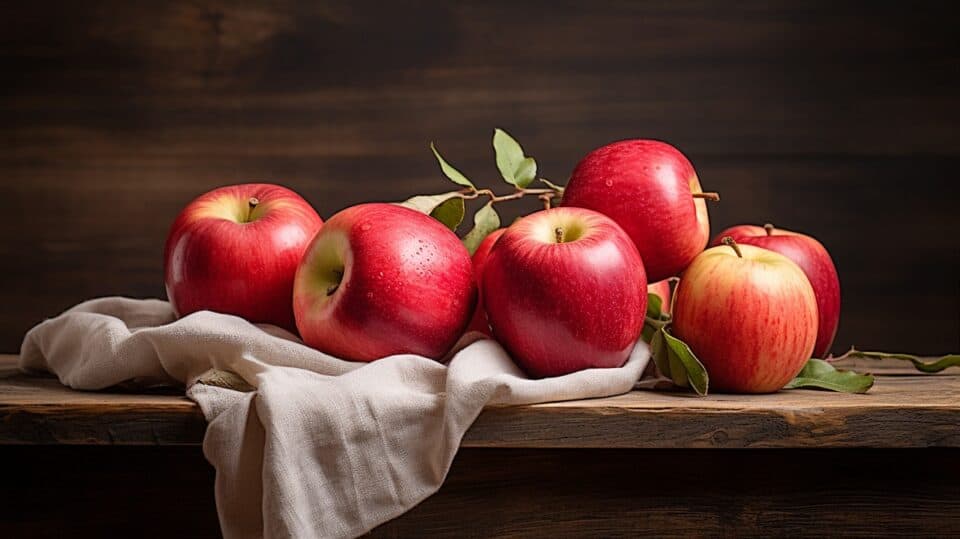
Fuji apples are originally from Fujisaki, Japan, where they were first cultivated in 1930. However, these days you can find Fuji apples grown all over the world. In addition to Japan, they are also grown in the United States and China.
On the other hand, Gala apples have a much wider range when it comes to their cultivation. They can be found virtually anywhere in the world! Specifically, Gala apples are cultivated in Washington (a major apple-growing region), as well as Europe, Chile, Argentina, and South Africa.
So no matter where you live, chances are you can easily find both Fuji and Gala apples at your local grocery store or farmer’s market.
When Are Fuji and Gala Apples in Season?
Fuji and Gala apples are both in season during the fall months, typically from September to November. This is the best time to find these varieties at their peak freshness and flavor. During this season, you can often find Fuji and Gala apples readily available at farmer’s markets or your local grocery store.
It’s worth noting that apples picked during their peak season tend to have better quality and taste compared to those stored for a longer period of time. So, if you’re planning on making an apple pie using Fuji or Gala apples, it’s best to get them fresh during their harvest season for the most delicious results.
The Taste of Fuji and Gala Apples
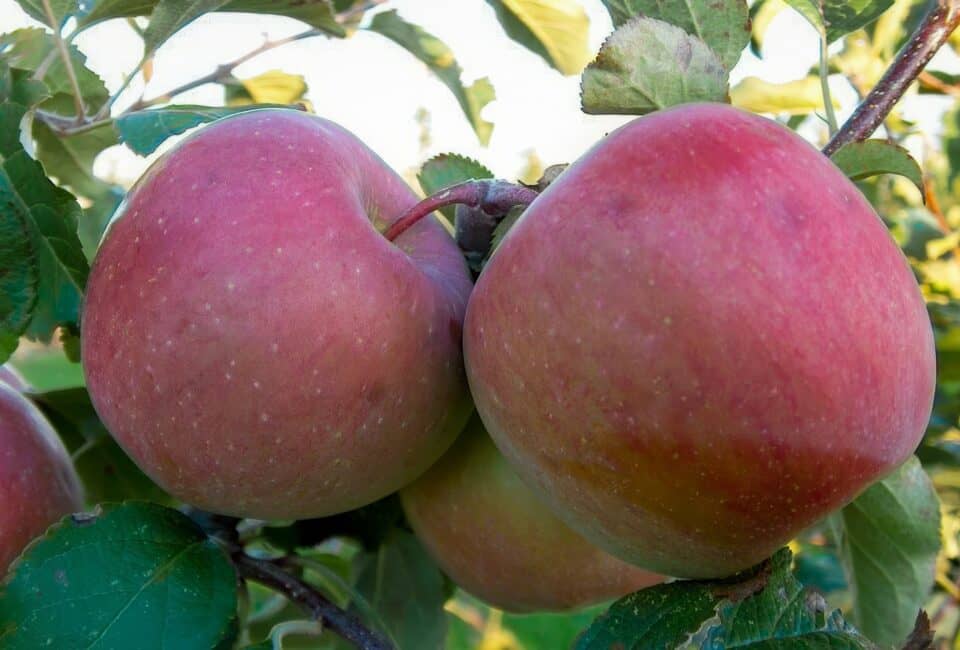
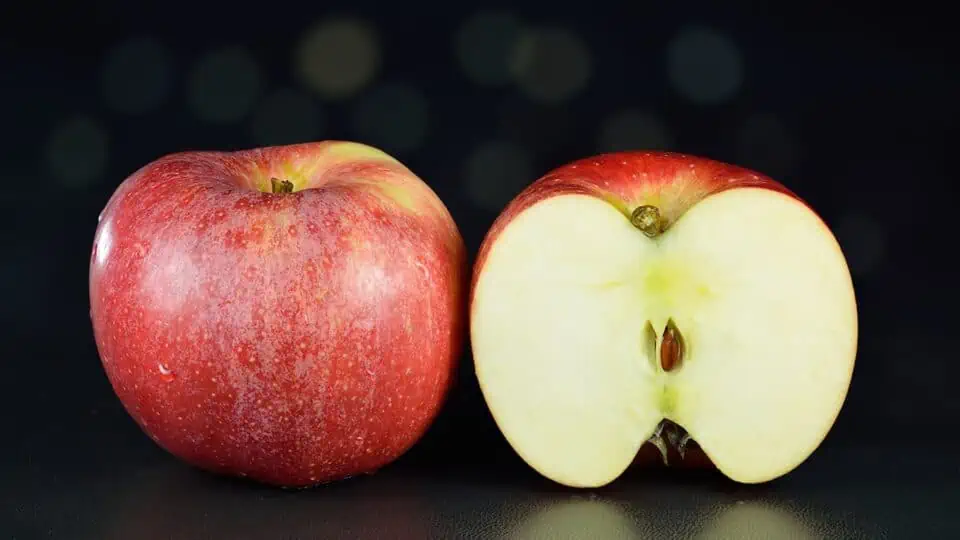
When it comes to creating a memorable apple pie, the taste of the apple you choose is crucial. Both Fuji and Gala apples are popular choices, but they each bring their own unique flavor profile to the table. Here, we will compare the taste of Fuji and Gala apples.
| Apple Variety | Taste Description |
|---|---|
| Fuji Apples | Fuji apples are known for their sweetness. They have a rich, honeyed flavor that provides a delightful counterbalance to the tart apple pie fillings. This sweetness is why Fuji apples are often selected for pies. |
| Gala Apples | Gala apples, on the other hand, offer a crisp and mildly sweet flavor. They’re slightly less sweet than Fuji apples, but their unique taste lends robustness to apple pies that are hard to match. Galas can stand alone or be combined with other apple varieties in a pie for a more complex flavor. |
Remember, the ideal apple pie filling should strike a balance between tart and sweet flavors. Both Fuji and Gala apples can contribute to this balance, but the choice ultimately depends on your personal preference and the specific flavor you want your apple pie to have.
The Texture of Fuji and Gala Apples
As a mom, you know texture is essential when selecting apples for your pie. Here’s a table that details the texture of Fuji and Gala apples.
| Apple Varieties | Texture When Raw | Texture When Baked |
|---|---|---|
| Fuji Apples | Fuji apples are known for their crisp, juicy texture when raw. | Despite their firmness raw, they become tender while still retaining some firmness when baked, which is ideal for apple pie. |
| Gala Apples | Raw Gala apples have a slightly softer texture but still provide a satisfying crunch. | When baked, Gala apples soften considerably, yet they don’t become mushy, making them a good choice for baking. |
Remember, the perfect apple pie should have a balance between tart and sweet flavors with a filling that’s tender but doesn’t lose its shape in the pie. So, when picking apples for your pie, it’s not just about flavor but texture too. Fuji and Gala apples, with their distinct textures, offer a fine balance in your apple pie-baking endeavor.
The Color of Fuji and Gala Apples
As moms, we often decide on the choice of our kids’ snacks based on their appearance. The same logic applies when choosing the perfect apple for our apple pie. The color of the apple not only gives our pie a delicious look but also contributes to the overall taste. So let’s compare the color of Fuji and Gala apples.
| Apple Type | Color Description |
|---|---|
| Fuji Apples | Fuji apples are larger and have a deeper red color with streaks of yellow and green. Their skin is reasonably thick and tough, which gives them a glossy appearance, making them an attractive option for your pie. |
| Gala Apples | Gala apples, on the other hand, are slightly smaller with a nice mix of bright orange-red color over a yellow background. They have a thin skin, which is notably smooth and shiny. This makes them look more appealing and perfect for a more vibrant-looking pie. |
So moms, while Fuji gives your pie a bold and deep appearance, Gala provides a vibrant and bright look. Both contribute to the flavor balance and enhance your pie’s visual appeal.
The Sweetness Level of Fuji and Gala Apples
Let’s dive into the sweetness of these two popular apple types that are often found in our kitchens and used as ingredients for our apple pies – Fuji and Gala.
| Apple Type | Sweetness Level |
|---|---|
| Fuji Apples | Fuji apples are noted for their high sweetness level. With a hint of tartness, it delivers a more citrusy edge that adds a pleasing balance to its sweetness. This makes them a fantastic choice when you want your apple pie to have a sweet and tangy kick. |
| Gala Apples | On the other hand, Gala apples offer a more mellow and balanced sweet-tart flavor. It’s not as sweet as Fuji apples, but its rich and full-bodied sweetness blends well with the other ingredients of the pie, resulting in a flavorful and harmonious apple pie. |
In conclusion, both Fuji and Gala apples have unique sweetness levels that can enrich the taste of your apple pie. Depending on your preference for sweetness and the flavor profile you desire, you can choose to use either or even mix both in your apple pie for an enhanced flavor.
Fuji Apples in Apple Pie
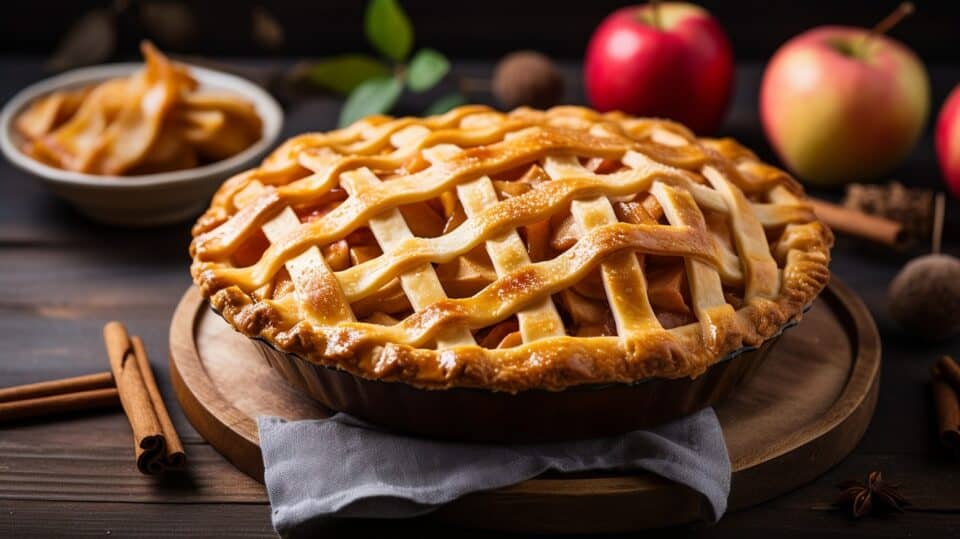
Fuji apples are known for their crisp texture and juicy sweetness, making them a popular choice for apple pie.
Characteristics & Description (Fuji Apples)
I absolutely love using Fuji apples in my apple pie! These apples have a perfect balance of sweet and tart flavors with a hint of citrusy goodness. They are larger and rounder than Gala apples, giving your pie a beautiful pop of deep red color.
When you take a bite of the pie, you’ll notice that Fuji apples have a crisp and less dense texture, which adds to the overall satisfaction of each bite. One thing I really appreciate about Fuji apples is that they hold their shape well when cooked, so your apple pie will not only taste amazing but also look visually appealing.
With their slightly sweeter taste and excellent baking qualities, Fuji apples are an ideal choice for creating the perfect apple pie filling.
Pros & Cons of using Fuji Apples in Apple Pie
Fuji apples are a popular choice for baking apple pie due to their unique characteristics. Let’s dive into the pros and cons of using Fuji apples in your apple pie.
| Pros | Cons |
|---|---|
| Fuji apples have a sweet yet tart taste, adding a delightful balance to your pie. | The sweetness of Fuji apples may not appeal to everyone, especially those who prefer a tart apple pie. |
| These apples are crisp and carry a firm bite, giving your pie a nice structure. | The crispness can sometimes result in a less creamy texture compared to other apple varieties. |
| The sturdy texture of Fuji apples allows them to hold their shape during baking, preventing a mushy filling. | Some people find the firm texture less desirable in a homemade apple pie. |
| Fuji apples’ size is generally larger, which could mean needing fewer apples for your pie filling. | The larger size might be a disadvantage if you’re aiming to blend multiple apple types in your pie. |
| Their redder skin can add a nice pop of color to your pie, especially if you leave some skin on. | The darker red color can sometimes darken the overall look of your pie, which might not be ideal for some bakers. |
Choosing the right apple for your pie depends on your personal preference. But considering the pros and cons of Fuji apples, they certainly make a good candidate for your apple pie.
Gala Apples in Apple Pie
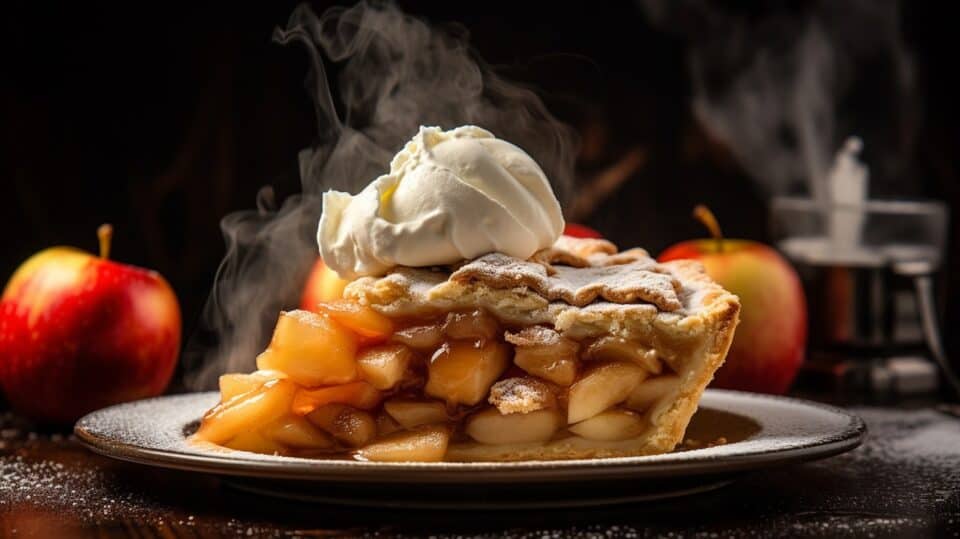
Gala apples are a popular choice for apple pie due to their crisp texture and sweet flavor.
Characteristics & Description (Gala Apples)
Gala apples are one of the most popular apple varieties and for good reason! These sweet and juicy apples have a mellow flavor with just the right amount of tartness. They have beautiful bright red skin that is often striped with yellow or orange, making them visually appealing as well.
The texture of Gala apples is soft and creamy, almost like biting into a delicate cloud. They are perfect for eating raw, as their sweetness really shines through. While Gala apples can be used in baking, they are not the best choice for apple pie fillings as they may become mealy when cooked for too long.
Instead, save these delicious beauties for snacking or using in salads where their natural sweetness can truly shine.
Pros & Cons of using Gala Apples in Apple Pie
One of the common choices for baking apple pies is Gala apples. However, they come with their own set of pros and cons.
| Pros | Cons |
|---|---|
| 1. Gala apples are readily available and easy to find at most grocery stores throughout the year. | 1. Gala apples lose their apple flavor after baking and tend to leave a mealy texture in your pie filling. |
| 2. They have an inherent sweetness which can help reduce the amount of sugar required in the pie recipe. | 2. Their soft texture does not hold up well in baking, resulting in a pie that lacks firm pieces of apple. |
| 3. Their vibrant red color can add a nice touch to the appearance of your pie, especially if some apple pieces are left unpeeled. | 3. They are not the ideal choice for baking, despite their sweetness and accessibility. |
Remember, choosing the right apple for your pie recipe can greatly influence the final taste and texture. Despite its sweetness, the Gala apple’s mealy texture might not make it the best choice for your apple pie. Consider pairing it with other apple varieties for a balanced flavor and texture.
Comparing the Uses of Fuji and Gala Apples in Other Recipes
As a mom, I know how important it is to find versatile ingredients that can be used in various recipes. When it comes to apples, both Fuji and Gala varieties have their own unique characteristics that make them perfect for different dishes.
In terms of flavor, Fuji apples are known for their sweet and slightly tart taste, making them ideal for enjoying fresh or adding a hint of sweetness to desserts like apple crisp or apple cake.
On the other hand, Gala apples are incredibly sweet with a mellow flavor profile, making them great for snacking on their own or incorporating into recipes that require a sweeter touch.
In terms of texture, Fuji apples tend to be firm and crunchy when bitten into. This makes them hold up well in baked goods like pies, where you want the apples to retain some bite even after being cooked.
Gala apples, on the other hand, have a softer and juicier texture which makes them excellent candidates for recipes where you want the apple slices to melt into the dish slightly.
While both Fuji and Gala apples can be scrumptious additions to your recipe repertoire, it’s essential to consider what type of flavor and texture you desire in each specific dish. Whether you’re looking for something sweet-tart or simply sweet with a softer consistency will determine whether you reach for Fuji or Gala when cooking up delicious creations in your kitchen!
Frequently Asked Questions About Whether Fuji or Gala Apples Are Better for Apple Pie
What are the differences between Fuji and Gala apples for apple pie?
Fuji apples are known for their crisp texture and sweet flavor, making them a popular choice for apple pie. Gala apples, on the other hand, have a milder flavor and softer texture that can lend themselves well to baking as well.
Can I use both Fuji and Gala apples together in an apple pie?
Yes! Mixing different varieties of apples can create a more complex flavor profile in your apple pie. Combining Fuji’s sweetness with Gala’s mildness can result in a delicious balance of flavors.
Are there any other apple varieties that work well for apple pies?
Absolutely! Other popular choices include Granny Smith (tart and firm), Honeycrisp (juicy and slightly tart), Jonagold (sweet-tart balance), or Pink Lady (tangy-sweet). Experimenting with different combinations can lead to unique and tasty results.
Can I substitute Fuji or Gala apples with another type of fruit in my apple pie?
While traditional apple pies call for apples, you can certainly consider using other fruits like pears or peaches to bring variety to your dessert. However, keep in mind that this may alter the taste and consistency of the final product, so make sure to adjust the recipe accordingly.
Conclusion
In conclusion, when it comes to choosing the best apple for apple pie, both Fuji and Gala have their unique qualities. Fuji apples offer a crisp texture and a sweet flavor profile that balances well with cinnamon and sugar in a pie.
On the other hand, Gala apples bring a pleasant tartness and firmness that holds up during baking. Ultimately, it boils down to personal preference – whether you prefer the sweetness of Fuji or the tartness of Gala.
So go ahead and experiment with these delicious apples to create your perfect homemade apple pie!
